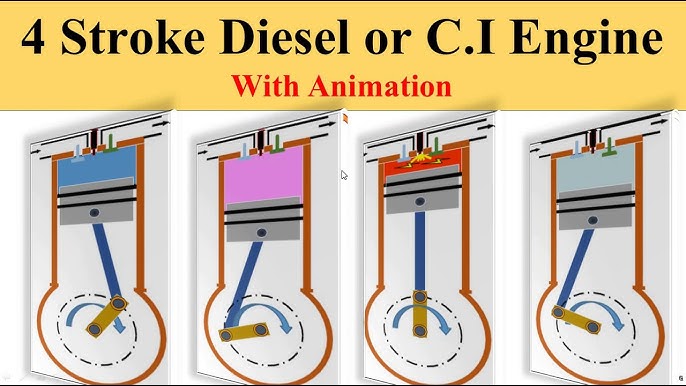4 stroke internal combustion engine|| Petrol Engine|| DieselEngine
Org code: arfxv
A four-stroke engine, also known as a four-cycle engine, is a type of internal combustion engine commonly used in cars, trucks, motorcycles, and many other applications. It completes a power cycle in four strokes of the piston (two revolutions of the crankshaft). Here is a general overview of how a four-stroke engine works:
Intake Stroke: The first stroke is the intake stroke. As the piston moves downward, it creates a partial vacuum in the cylinder. The intake valve opens, allowing a fuel-air mixture to enter the combustion chamber from the intake manifold. The piston moves downward, drawing in the fresh mixture.
Compression Stroke: Once the piston reaches the bottom of the intake stroke, the intake valve closes. The piston then moves upward, compressing the fuel-air mixture. Both the intake and exhaust valves are closed during this stroke, trapping the mixture in the combustion chamber. The compression increases the pressure and temperature of the mixture.
Power Stroke: At the top of the compression stroke, when the piston is near the top of the cylinder, the spark plug ignites the compressed fuel-air mixture. The ignited mixture expands rapidly, generating high pressure. This pressure pushes the piston downward, creating the power stroke. The power stroke is the working stroke where the engine produces mechanical work to drive the crankshaft.
Exhaust Stroke: After the power stroke, the piston moves upward again. The exhaust valve opens, and the remaining burning gases are expelled from the combustion chamber into the exhaust manifold. The piston moves upward, pushing the exhaust gases out through the open exhaust valve. Towards the end of the exhaust stroke, the exhaust valve closes, and the intake valve begins to open, preparing for the next intake stroke.
The four-stroke engine has separate intake and exhaust valves that are operated by a camshaft. The camshaft controls the opening and closing of the valves at precise timing intervals. The camshaft is driven by the crankshaft through a timing belt or chain.
This four-stroke cycle of intake, compression, power, and exhaust repeats continuously as the engine operates. The engine's rotational motion is transmitted to the crankshaft, which converts the linear motion of the piston into rotary motion. The crankshaft is connected to the transmission or other output devices, which then transfers the power to the wheels, propellers, or other mechanical systems.
The four-stroke engine is known for its efficiency, durability, and relatively low emissions compared to two-stroke engines. It provides a smoother power delivery and better fuel economy. However, it is more complex in design and requires additional components such as valves, camshafts, and timing systems compared to two-stroke engines.
4 stroke internal combustion engine|| Petrol Engine|| DieselEngine
Org code: arfxv
A four-stroke engine, also known as a four-cycle engine, is a type of internal combustion engine commonly used in cars, trucks, motorcycles, and many other applications. It completes a power cycle in four strokes of the piston (two revolutions of the crankshaft). Here is a general overview of how a four-stroke engine works:
Intake Stroke: The first stroke is the intake stroke. As the piston moves downward, it creates a partial vacuum in the cylinder. The intake valve opens, allowing a fuel-air mixture to enter the combustion chamber from the intake manifold. The piston moves downward, drawing in the fresh mixture.
Compression Stroke: Once the piston reaches the bottom of the intake stroke, the intake valve closes. The piston then moves upward, compressing the fuel-air mixture. Both the intake and exhaust valves are closed during this stroke, trapping the mixture in the combustion chamber. The compression increases the pressure and temperature of the mixture.
Power Stroke: At the top of the compression stroke, when the piston is near the top of the cylinder, the spark plug ignites the compressed fuel-air mixture. The ignited mixture expands rapidly, generating high pressure. This pressure pushes the piston downward, creating the power stroke. The power stroke is the working stroke where the engine produces mechanical work to drive the crankshaft.
Exhaust Stroke: After the power stroke, the piston moves upward again. The exhaust valve opens, and the remaining burning gases are expelled from the combustion chamber into the exhaust manifold. The piston moves upward, pushing the exhaust gases out through the open exhaust valve. Towards the end of the exhaust stroke, the exhaust valve closes, and the intake valve begins to open, preparing for the next intake stroke.
The four-stroke engine has separate intake and exhaust valves that are operated by a camshaft. The camshaft controls the opening and closing of the valves at precise timing intervals. The camshaft is driven by the crankshaft through a timing belt or chain.
This four-stroke cycle of intake, compression, power, and exhaust repeats continuously as the engine operates. The engine's rotational motion is transmitted to the crankshaft, which converts the linear motion of the piston into rotary motion. The crankshaft is connected to the transmission or other output devices, which then transfers the power to the wheels, propellers, or other mechanical systems.
The four-stroke engine is known for its efficiency, durability, and relatively low emissions compared to two-stroke engines. It provides a smoother power delivery and better fuel economy. However, it is more complex in design and requires additional components such as valves, camshafts, and timing systems compared to two-stroke engines.
























No comments:
Post a Comment